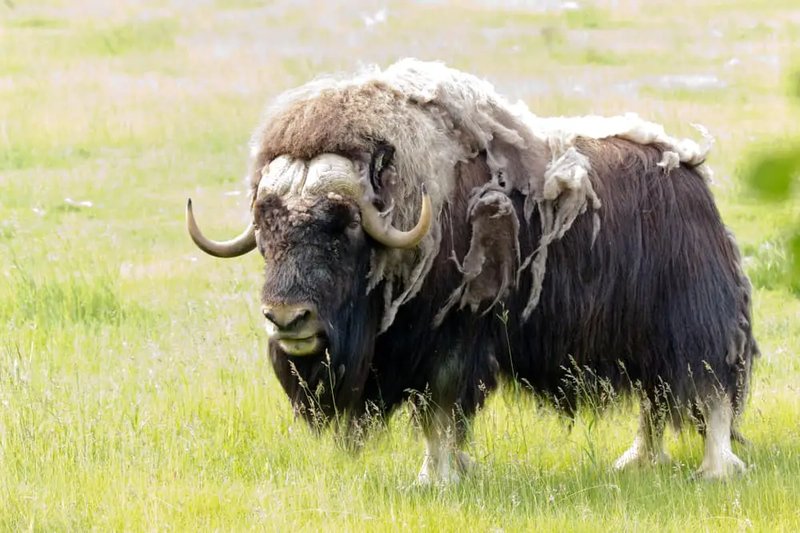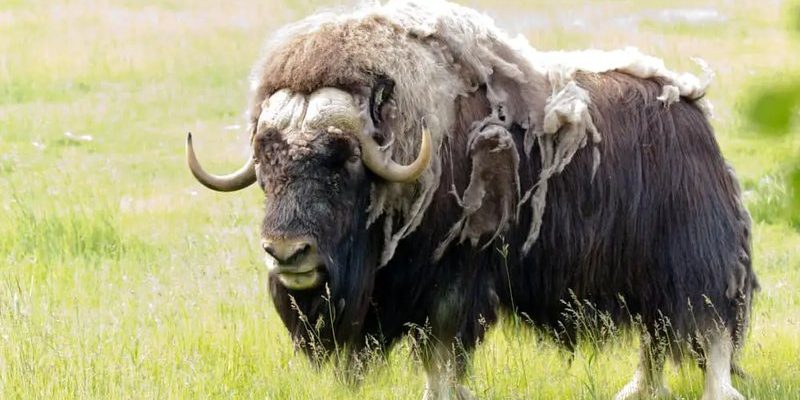
In this article, we’re going to dive deep into the animal kingdom to explore 10 animals similar to the muskox. You might be wondering how to tell these creatures apart, especially if you ever find yourself on a wildlife safari or studying wildlife documentaries. By the end, you’ll not only be able to recognize a muskox but also distinguish it from its lookalikes. So, grab a warm drink, settle in, and let’s get started!
1. Bison: The American Plains Giant
Bison are often thought of as the American counterpart to the muskox. They share a similar stocky build and heavy fur, but there are key differences. Bison are generally larger, reaching up to 2,000 pounds, while muskoxen typically weigh between 600 and 900 pounds. One thing that stands out about bison is their massive hump at the shoulders, which is particularly prominent compared to the muskox.
You might also notice that bison have a more pronounced beard of hair under their chin that’s often missing in muskoxen. Plus, the bison’s rear end is more rounded, while a muskox has a more barrel-shaped body. Both animals have horns, but bison’s horns are shorter and curve upwards more noticeably.
2. Yak: The Woolly Mountain Dweller
Yaks are another animal that brings to mind a similarity with muskoxen, especially when it comes to their long, shaggy fur. Yet, you can usually find yaks in higher altitudes, mainly in the Himalayas. They have a broader body and are more suited to rocky terrains compared to the muskox, which prefers more open tundra.
To tell them apart, look at the tails. Yaks have long, bushy tails that often hang down, while muskoxen have shorter, more tufted tails. Additionally, yaks have distinct, long hair along their sides, giving them an almost flowing appearance as they move. Both animals can tolerate cold weather remarkably well, but yaks have a higher adaptability to altitude.
3. Goat Antelope: The Serengeti’s Agile Grazers
Now let’s hop over to Africa and meet the goat antelope, or more commonly known as the African antelope. Though not as hefty as the muskox, goat antelopes share a similar color palette—often brown or dark gray. However, the differences are noticeable once you take a closer look.
One major distinction is in their size. Goat antelopes are generally much smaller, weighing around 100 to 200 pounds. They also have long, slender legs that allow them to run quickly from threats, whereas muskoxen have stockier, more robust frames built for endurance in harsh climates. The horns of goat antelopes are also typically more elongated and pointed compared to the curled horns of a muskox.
4. Sheep: The Furry Farm Favorite
You might think sheep are just fluffy farm animals, but some wild sheep species can resemble muskoxen in their stocky builds and thick coats. Take, for example, the Dall sheep found in North America. Dall sheep have a similar body shape but differ greatly in habitat preference and appearance.
Unlike muskoxen, Dall sheep have a more slender build and are much lighter, usually weighing around 150 to 250 pounds. The horns of a Dall sheep are also much curlier and thinner, spiraling outwards, while muskoxen’s horns grow outward and backward. If you ever spot one in the wild, you’ll notice Dall sheep are usually found in mountainous areas, not the tundra where muskoxen thrive.
5. Reindeer: The Arctic Nomads
When you think of the Arctic, reindeer might be one of the first animals to come to mind, especially if you’re familiar with holiday traditions. Reindeer are similar in size to muskoxen and share their habitat in the tundra. However, there are a few standout differences.
For starters, reindeer tend to have longer legs and a more elegant body shape compared to the stockier muskox. They also sport antlers that can be much larger and have a branching structure. One of the most entertaining differences is that both male and female reindeer grow antlers, which isn’t the case for muskoxen—only the males have horns.
6. Caribou: The North American Cousin
Many people confuse caribou with reindeer, but they are essentially the same species, with caribou being the North American name for reindeer. Like their relatives, caribou have a more graceful build compared to the muskox.
They have agile bodies that can run fast, making them well-adapted for migration. Muskoxen, on the other hand, are more adapted for endurance in harsh conditions. The fur of a caribou is also short and sleek, while a muskox has long, shaggy hair. You might find caribou in herds migrating across vast distances, while muskoxen tend to form smaller groups.
7. Takin: The Himalayan Resilient
The takin is a lesser-known member of the goat-antelope family that roams the rugged terrains of the Himalayas. At first glance, takins have a somewhat bulky build, which can remind you of a muskox. However, the takin’s distinctive features set it apart.
With a heavy, beard-like coat and unique snooty facial structure, the takin has a lot of character. They are also much more agile than muskoxen, adept at climbing the rocky landscapes of their mountainous habitats. Plus, takins usually have shorter, horn-like features that are more linear compared to the prominent curled horns of the muskox.
8. Saiga Antelope: The Oddball of the Steppe
The saiga antelope is another fascinating animal that’s visually striking but very different from the muskox. Known for its distinctive bulbous nose, the saiga has a unique adaptation that helps filter dust and regulate body temperature in its dry habitat.
While both saiga and muskoxen face environmental challenges, their appearances are quite divergent. Saiga are much smaller, weighing about 100 to 150 pounds, and have long, slender legs compared to the robust structure of a muskox. The saiga’s coat is also thinner, making it less suited for cold climates than the incredibly insulated muskox.
9. Guar: The Indian Bison
The guar, or Indian bison, is another large herbivore that shares a robust build similar to that of the muskox. Found in forested regions of South Asia, guar can weigh up to 2,200 pounds, making them heavier than muskoxen. What sets them apart, aside from their size, is their muscular structure and glossy black coat.
Unlike muskoxen, which are thickly furred for cold climates, guars have shorter, sleeker fur. Their horns are also larger and more curved, which gives them a distinctive silhouette compared to the muskox. Plus, guars thrive in lush, green environments, while muskoxen have adapted to the cold tundra.
10. Water Buffalo: The Domesticated Heavyweight
Last but not least, the water buffalo shares a few physical traits with the muskox, like their stout bodies and thick hides. However, their behavior and habitats diverge sharply. While muskoxen are wild animals, water buffalo have been domesticated for thousands of years and are commonly found in farms across Asia.
Water buffalo typically have very prominent horns that sweep outwards, giving them a very different look compared to muskoxen. They also have less dense fur, adapting better to warmer climates rather than the frigid environments muskoxen call home.
In conclusion, while the muskox is a fascinating creature on its own, many similar animals roam our planet. Each has unique traits and adaptations to survive in their respective environments. Next time you hear about a muskox, you’ll have a better idea of its relatives and how to identify them. Isn’t nature wonderfully diverse? Whether you’re a wildlife enthusiast or just curious, knowing these distinctions can enhance your appreciation for the animal kingdom. Happy exploring!

